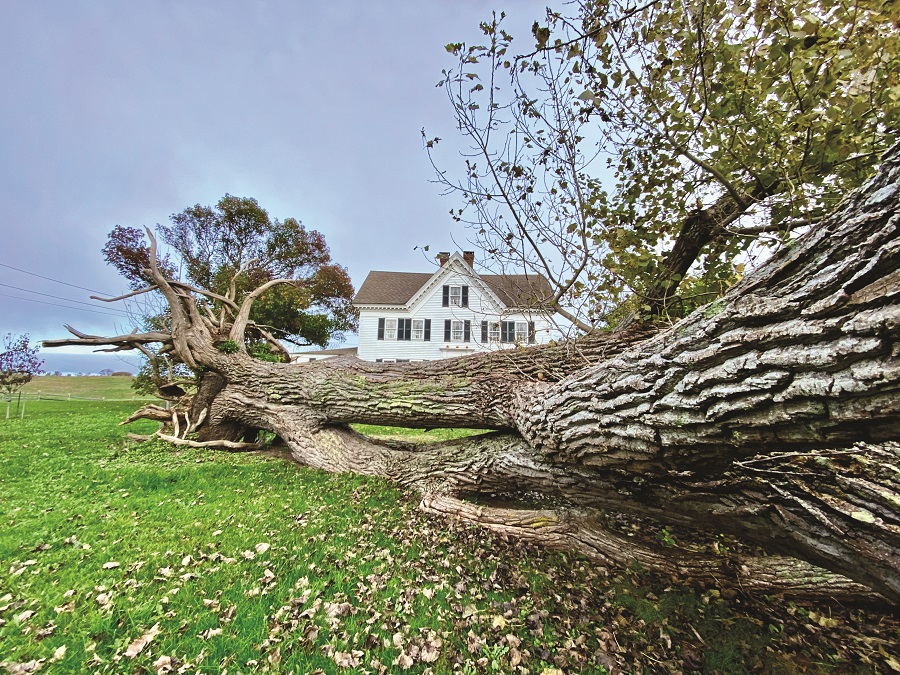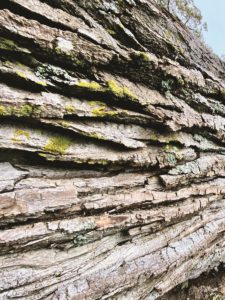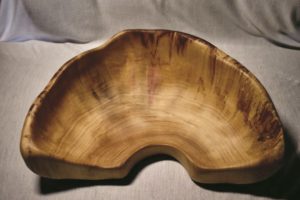EASTHAM — The road to Fort Hill winds through low, rolling fields. Just before it climbs the last hill to the parking area overlooking the inlet, it passes something that catches the eye: off to the right, a flare of sun-bleached roots reaches skyward, framing the view of a pleasantly symmetrical old farmhouse.
The roots belong to a massive tree. She is on her side. Her long body rests heavy on the lawn, hips and shoulders settled into the wet ground. Her trunk is so thick you cannot see over it. Deeply furrowed bark runs her entire length. On her downward side, exposed wood stripped of this thick armor — an old scar — runs from her root flare into her branches.

“She — I call her ‘She,’ ” says Sarah Burrill, “was struck by lightning in 2011.” Burrill is the owner of the home on Fort Hill where the cottonwood stood for more than 150 years.
Cottonwoods are not native here. Local legend has it that Capt. Edward Penniman brought cottonwood seeds to Eastham from Chicago, where he lived in the winters while building his house.
Sitting on the far side of a dining room table with a cup of tea, Burrill tells the story of the tree in a voice gentle and steady.
“It was a direct hit,” she says. “It killed her middle limb and damaged some of her root system. It’s part of the reason she came down in one of the nor’easters we had in March 2018.”
Burrill speaks of the cottonwood the way one speaks of a family member. Familiar. Tender. Their stories are intertwined. “I grew up in that tree,” she says. “There’s so much comfort and solace in it. And escape.”

That year, 2018, a series of powerful nor’easters passed through this end of Cape Cod. Fort Hill and the cottonwood tree sit in a direct northeast fetch from the expanse of the Atlantic Ocean. The tree, in its compromised state, gave and fell.
Assuming the tree was dead, everyone now wanted to know its long story. Visitors stopped by to ask about it. The phone rang. The newspapers assigned reporters to describe the fallen cottonwood. People offered to come with their chainsaws to remove the tree for free, to offer a clean ending to the story.
But there is something patient about the property at Fort Hill. Better not to rush things, Burrill thought. “Give something its time,” Burrill says through the steam rising in slow curls from the tea. It is a thought spoken to all things. The tree was allowed to rest on the lawn. Chicory and dandelion nestled in a clump of soil brought up in its roots and bloomed purple and yellow.
Come April of that year, as the ground softened and the fields around Fort Hill began to awaken, so, too, did the fallen cottonwood. “April came, and there were buds,” Burrill recalls. “And there were leaves on it all summer long.”
Cottonwoods grow fast. Their interior wood is light, and their live tissue is malleable. When this one fell, half of her root system remained in the ground, and the wood that carries water to her canopy bent but did not break. She flushed with leaves that first spring and has done so every spring since.
After the lightning strike, the large middle limb, once so tall it could be seen from out at sea, died and came down. Burrill collected the fallen wood and began carving bowls. The bowls are light, intuitive and elegant in their simplicity. Their surfaces are patterned like a topography, with staining from fungi that lived in the tree. Little blackened holes in tight clusters tell of bugs that burrowed into the tree’s soft wood.

“You start working, and it starts to tell its story,” Burrill says of a bowl held in her long fingers. “This was the very first one I did. I started, and then it split.” For some, this might be an ending. “I thought, well, what if I just see where the split goes.”
Looking out the window at a cherry tree whose roots grow through the ashes of a sister lost long ago, Burrill says, “In our culture, we are so ready to dismiss those who are struggling or those who fall.”
About the cottonwood, she says, “I love her standing up. I love her lying down.”
In the very middle of the bare earth where the cottonwood stood, a sapling grows. It came up in 2020 and now stands 15 feet tall. “It is not a seedling,” Burrill says, “but a tree born of the root system that remained in the ground. It is the cottonwood tree herself.”
Steam rises from the tea. An imperfect bowl sits on the table. “The story is not over,” Burrill says. “I don’t know the story yet.”
